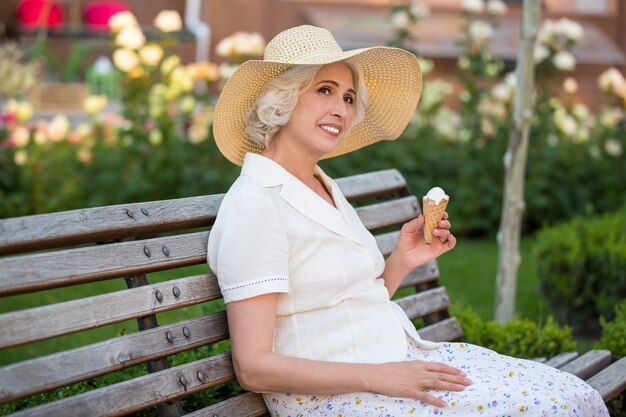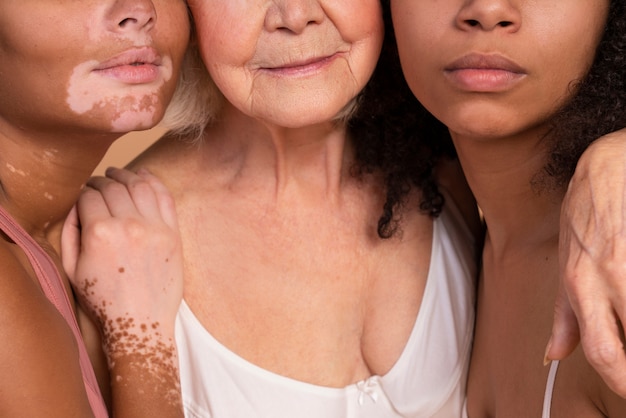Sun Safety for Seniors: Preventing Skin Cancer Risks

Protecting your skin is crucial for seniors to prevent skin cancer; this involves strategies like using sunscreen, wearing protective clothing, and seeking shade, especially during peak sun hours.
As we age, our skin becomes more vulnerable to sun damage, increasing the risk of skin cancer. Protecting Your Skin: Sun Safety Tips for Seniors to Prevent Skin Cancer is not just a matter of comfort, it’s a crucial aspect of healthy aging.
Understanding Skin Cancer Risks in Seniors
Seniors face a heightened risk of skin cancer due to cumulative sun exposure over their lifetime and a natural decline in the skin’s ability to repair itself. Understanding these risks is the first step in effective prevention.
Awareness of individual risk factors and diligent skin monitoring play significant roles in early detection and treatment. Let’s explore why seniors are particularly susceptible.
Why Seniors Are More Vulnerable
Several factors contribute to the increased vulnerability of seniors to skin cancer. These include:
- Cumulative Sun Exposure: Decades of sun exposure accumulate, damaging skin cells over time.
- Weakened Immune System: The immune system naturally weakens with age, reducing its ability to fight off cancerous cells.
- Thinner Skin: Aging skin becomes thinner and less elastic, offering less protection against UV radiation.
Types of Skin Cancer Common in Seniors
Understanding the different types of skin cancer can help seniors and their caregivers recognize potential issues early. The most common types include:
- Basal Cell Carcinoma (BCC): Often appears as a pearly or waxy bump, most frequently on sun-exposed areas.
- Squamous Cell Carcinoma (SCC): May present as a firm, red nodule or a flat lesion with a scaly, crusted surface.
- Melanoma: The most dangerous form of skin cancer, often appearing as an unusual mole or a dark spot on the skin.

Regular self-exams and professional skin checks are vital for early detection. Keep an eye out for changes in moles or any new, unusual spots.
Recognizing the unique vulnerabilities and common types of skin cancer, seniors can take proactive steps to protect themselves and maintain healthy skin.
The Importance of Sunscreen for Older Adults
Sunscreen is a cornerstone of sun safety, regardless of age, but it’s especially important for older adults. Consistent use of sunscreen helps to shield the skin from harmful UV rays, reducing the risk of skin cancer and premature aging.
Choosing the right sunscreen and applying it correctly can make a significant difference. Here are some points to consider.
Choosing the Right Sunscreen
With so many sunscreens available, it can be overwhelming to choose the right one. Look for these key features:
- Broad-Spectrum Protection: Offers protection against both UVA and UVB rays.
- SPF 30 or Higher: Provides adequate protection for most outdoor activities.
- Water Resistance: Choose a water-resistant formula, especially if you’ll be sweating or swimming.
How to Apply Sunscreen Properly
Applying sunscreen correctly is just as important as choosing the right product. Follow these tips for optimal protection:
- Apply Generously: Use about one ounce (a shot glass full) to cover the entire body.
- Apply 15-30 Minutes Before Sun Exposure: This allows the sunscreen to bind to the skin.
- Reapply Every Two Hours: Or more frequently if swimming or sweating.
Don’t forget often-missed areas like the ears, neck, and tops of the feet. It’s also essential to use sunscreen even on cloudy days, as UV rays can penetrate clouds.
Incorporating sunscreen into your daily routine is a simple yet highly effective way to protect your skin. Make it a habit to apply before any outdoor activity.
Protective Clothing: Your First Line of Defense
In addition to sunscreen, protective clothing offers another effective layer of defense against the sun’s harmful rays. Wearing the right clothing can significantly reduce your exposure to UV radiation.
Choosing the right materials and styles can enhance your comfort and protection. Let’s explore the best options for sun-safe clothing.
Best Types of Clothing for Sun Protection
When selecting clothing for sun protection, consider these factors:
- Fabric Type: Tightly woven fabrics like denim, canvas, and broadcloth offer better protection than loosely woven materials.
- Color: Darker colors absorb more UV rays than lighter colors, providing greater protection.
- Coverage: Opt for long sleeves, long pants or skirts, and high necklines to cover as much skin as possible.
Hats and Sunglasses: Essential Accessories
Don’t forget to protect your head, face, and eyes with the right accessories:
- Wide-Brimmed Hats: Choose a hat with at least a 3-inch brim to shield your face, ears, and neck.
- Sunglasses: Select sunglasses that block 99-100% of UVA and UVB rays to protect your eyes and the delicate skin around them.

Consider investing in clothing with an Ultraviolet Protection Factor (UPF) rating. UPF indicates how much UV radiation a fabric can block. Look for clothing with a UPF of 30 or higher for good protection.
Protective clothing acts as a physical barrier against the sun, complementing the protection provided by sunscreen. Make these items a regular part of your sun safety strategy.
Seeking Shade: A Simple Yet Powerful Strategy
Seeking shade is one of the simplest and most effective ways to minimize sun exposure. Finding a shaded spot, especially during peak sun hours, can significantly reduce your risk of sun damage.
However, shade alone isn’t a complete solution. Understanding how to maximize shade and supplementing it with other protective measures is crucial.
The Best Times to Seek Shade
The sun’s rays are strongest between 10 a.m. and 4 p.m. During these peak hours, make an effort to seek shade whenever possible. Plan outdoor activities for early morning or late afternoon when the sun is less intense.
- Plan Outdoor Activities: Schedule outings for times when the sun is less intense.
- Know the UV Index: Pay attention to daily UV index forecasts and take extra precautions on high-UV days.
Creating Your Own Shade
If natural shade isn’t available, create your own using umbrellas, canopies, or portable shelters. These can be especially useful for outdoor events or activities where you’ll be spending extended periods in the sun.
- Use Umbrellas and Canopies: Provide instant shade wherever you go.
- Consider Portable Shelters: Ideal for picnics, beach outings, and other outdoor events.
Remember that shade doesn’t provide complete protection. UV rays can still reflect off surfaces like water, sand, and concrete. Always supplement shade with sunscreen and protective clothing for comprehensive sun safety.
Integrating shade into your sun protection routine is a practical way to reduce your exposure to harmful UV rays. Make it a habit to seek shade, especially during peak sun hours, for a healthier and safer outdoor experience.
Regular Skin Checks: Early Detection Saves Lives
Regular skin checks are essential for early detection of skin cancer. Both self-exams and professional skin screenings play crucial roles in identifying potential problems before they become serious.
Learning how to perform self-exams and knowing when to see a dermatologist can significantly improve your chances of successful treatment. So, let’s understand more!
Performing Self-Exams
Self-exams should be performed monthly. Use a mirror to check all areas of your body, including your back, scalp, and the soles of your feet. Look for any changes in existing moles or the appearance of new, unusual spots.
Follow these tips for an effective self-exam:
- Use a Full-Length Mirror: Check all areas of your body.
- Pay Attention to Moles: Look for changes in size, shape, color, or texture.
- Note New Spots: Be aware of any new moles or spots that appear.
The Importance of Professional Skin Screenings
In addition to self-exams, regular skin screenings by a dermatologist are crucial. A dermatologist can identify suspicious lesions that may be difficult to see on your own.
Schedule a professional skin exam:
- Annually: Or more frequently if you have a history of skin cancer or a high risk.
- With a Dermatologist: Who specializes in skin health and cancer detection.
Early detection of skin cancer significantly increases the chances of successful treatment. Make regular skin checks a priority, combining self-exams with professional screenings for comprehensive protection.
By prioritizing skin checks, seniors can take a proactive approach to their health, increasing the likelihood of early detection and successful treatment.
Debunking Common Sun Safety Myths
Many misconceptions about sun safety can lead to inadequate protection. Debunking these myths is essential to ensure seniors are equipped with accurate information to protect their skin.
Let’s address some of the most common sun safety myths and provide clarity on how to protect yourself effectively.
Myth: You Only Need Sunscreen on Sunny Days
Truth: UV rays can penetrate clouds, making sunscreen necessary even on overcast days. Up to 80% of the sun’s UV rays can reach the earth on a cloudy day.
Myth: A Base Tan Protects You from Sunburn
Truth: A tan is a sign of skin damage, not protection. While a tan may provide a slight SPF of around 3, it’s not enough to prevent sunburn or reduce your risk of skin cancer.
Myth: Sunscreen Is Only Necessary at the Beach or Pool
Truth: Sunscreen should be worn whenever you’re outdoors, regardless of the activity. UV exposure occurs even during everyday activities like gardening, walking, or driving.
Myth: Darker Skin Tones Don’t Need Sunscreen
Truth: While darker skin tones have more melanin, which provides some natural protection, everyone is susceptible to sun damage and skin cancer. Sunscreen is essential for all skin types.
By dispelling these common myths, we can promote more effective sun safety practices and help seniors protect their skin with accurate information. Knowledge is power when it comes to preventing sun damage and skin cancer.
| Key Point | Brief Description |
|---|---|
| ☀️ Sunscreen Use | Apply broad-spectrum SPF 30+ daily, reapplying every two hours. |
| 👒 Protective Clothing | Wear hats, sunglasses, and long sleeves to minimize sun exposure. |
| ⛱️ Seek Shade | Limit sun exposure between 10 a.m. and 4 p.m. by seeking shade. |
| 🔎 Regular Skin Checks | Perform self-exams monthly and visit a dermatologist annually. |
Frequently Asked Questions (FAQs)
▼
▼
▼
▼
▼
Conclusion
Protecting Your Skin: Sun Safety Tips for Seniors to Prevent Skin Cancer is a multifaceted approach that includes consistent sunscreen use, wearing protective clothing, seeking shade during peak hours, and performing regular skin checks. By adopting these practices, seniors can significantly reduce their risk of skin cancer and enjoy a healthier, more vibrant life.
